Last Updated on October 26, 2025 by Owen McGab Enaohwo
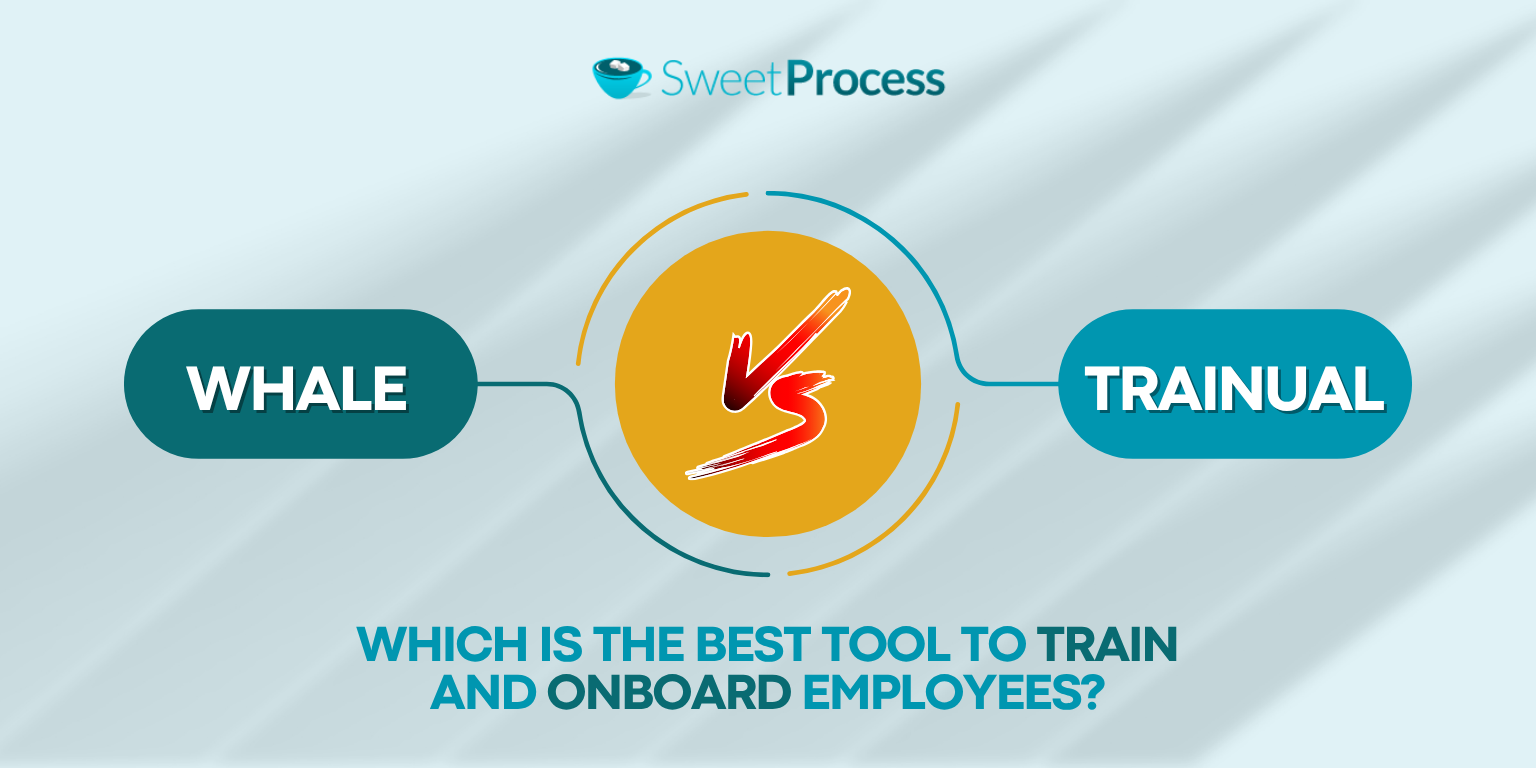
You’ve finally made the hire, but now comes the real test—training them fast without draining your team’s time. Yet, statistics show that 36% of employers still have no structured employee onboarding process, leaving new hires to figure it out on their own. That lack of training structure is a huge problem because it affects productivity, morale, and employee retention.
Tools like Whale and Trainual are ideal for such situations. Both training tools provide a platform that centralizes and speeds up the onboarding process. But which one is the better fit for your team? This detailed comparison guide for Whale vs. Trainual will break down the features, similarities, and differences of each tool so you can confidently choose the best tool for your training and onboarding needs.
Table of Contents
Whale vs Trainual: Key Differences
Whale vs Trainual: Key Similarities
SweetProcess: The Whale and Trainual Alternative For Training Employees
Whale vs Trainual: Which Is Better for Employee Training and Onboarding?
What Is Whale?
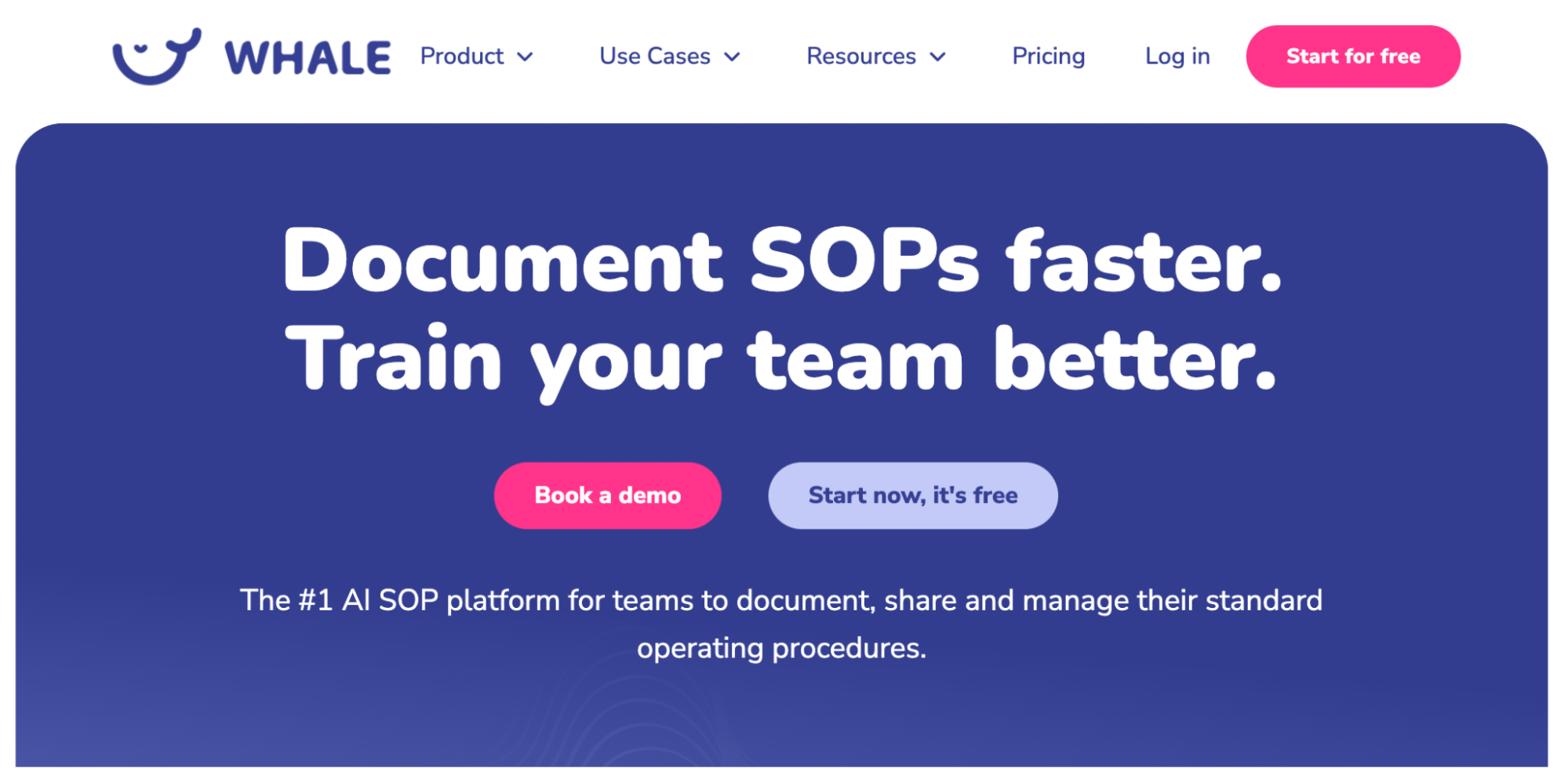
Whale is an all-in-one knowledge management and training tool that organizations use to document standard operating procedures (SOPs) and company documentation. This tool allows you to transform your company procedures into training manuals for new hires to learn more about their roles. Additionally, employees can access SOPs and onboarding materials from one centralized platform.
Here are the key features of Whale:
- Training workflows: This platform can automate the learning process based on specific roles.
- Playbook creation: Whale offers a tool for building and sharing training manuals, SOPs, and process guides across teams.
- Quizzes: You can assess your team to determine whether they have understood and retained the information.
- Templates: The available templates make creating SOPs and training documentation easy.
- Reporting capabilities: As you train and onboard new employees, you can track the progress and identify team members who need more help with their assignments.
Whale caters to various organizations that require quick access to up-to-date documentation without having to sift through shared folders or outdated manuals.
What Is Trainual?

Trainual is a comprehensive training and employee onboarding software that allows you to systemize operations. You can use this tool to build structured learning experiences for your team members. This way, it becomes easier to transfer company knowledge and train the new hires on the expected responsibilities.
Thanks to the robust features and user-friendly interface, Trainual is ideal for use in sectors such as human resources, marketing, and advertising. Here are some of its core features:
- Training manual builder: With this tool, you can create step-by-step documentation, guides, and SOPs that come in handy during training.
- Integrations: Trainual seamlessly integrates with various apps and HR systems, enabling easy onboarding of employees from a single platform.
- Centralized documentation: Thanks to the centralized repository, your team can access all policies, processes, and SOPs from one place to facilitate knowledge sharing and transfer.
- Employee handbook: The trackable handbooks provide the right information about employee roles and responsibilities.
- Organization chart and directory: Using this tool, you can easily visualize the team structure and assign responsibilities.
Whale vs Trainual: Key Differences

Choosing the right onboarding tool goes beyond just the features. You have to determine whether the software aligns with your team’s structure, goals, and company size. While both Whale and Trainual have unique features, here are their key differences to help you decide:
Target Audience
Not all training tools are built for the same kind of company. When you compare these two, Whale is ideal for small and mid-sized businesses, especially teams that need an easy-to-adopt solution for sharing internal knowledge quickly. This makes it ideal for lean teams, startups, or remote-first businesses that want minimal setup and fast access to SOPs.
On the other hand, Trainual is built for scaling businesses that require more structured onboarding processes. Therefore, it’s useful for organizations with multiple departments, clearly defined roles, and frequent hiring. This platform can be used to create long-term training plans, automate knowledge delivery by role, and enforce consistency through tests and e-signatures.
Larger teams and companies can use Trainual because of its more robust systemization.
E-Signature
Companies use e-signatures to formally acknowledge that training has been completed, which is ideal for safety procedures. Trainual includes built-in e-signature functionality, allowing employees to sign off on specific training content. This feature is great for team accountability, as it requires adding it at the end of each topic.
Whale doesn’t offer native e-signature capabilities. While you can track task completion or mark items as done, it doesn’t allow for formal signatures or legal acknowledgment within the platform.
Visual Task Delegation
Both tools allow task assignment, but how tasks are displayed and tracked differs. Trainual stands out in visual task management. Managers can assign training to specific roles or individuals and view progress through visual dashboards, status bars, and notifications. This makes it easy to see which team members are falling behind or need reminders, all without leaving the dashboard.
Whale offers a simpler approach. You can assign training content to users, who can check it off as they complete it. However, the interface lacks visual progress tracking and comprehensive dashboards, as the platform uses a checklist system.
Customer Support

Customer support is an important feature to consider when adopting a tool, especially at the early stage. With Trainual, you get more hands-on support options. It offers live chat, email support, a comprehensive help center, and overall, an onboarding software for customers to help teams get started. There are FAQs and help documents that provide important information.
On the other hand, Whale also provides a live chat and useful documentation. Therefore, their communication channels are more limited than those of Trainual.
Flowcharts and Role Chart
Seeing how processes and people connect is crucial for managing scale and clarity. Flowcharts make this possible by providing a visual representation of these processes. When you use Trainual, you can access an interactive organizational chart that visually maps out your company structure. You can assign training by department, role, or location, making it ideal for organizations with layered hierarchies or cross-functional teams. You also receive role-based permissions, ensuring that employees access only relevant content.
With Whale, you get visual SOPs and process flows through its playbook builder, which is great for illustrating how a task is done. However, it doesn’t provide a full org chart or structured role hierarchy. It’s better for tactical, process-level visibility rather than organizational structure.
Integrations
Your business already has several systems. Integrations make the tool a part of your larger ecosystem. Trainual integrates with a broader range of tools, including Slack, Loom, QuickBooks, BambooHR, Google Workspace, and Zapier. This enables HR teams to automate onboarding steps, such as adding new hires, assigning content, and syncing payroll and compliance data.
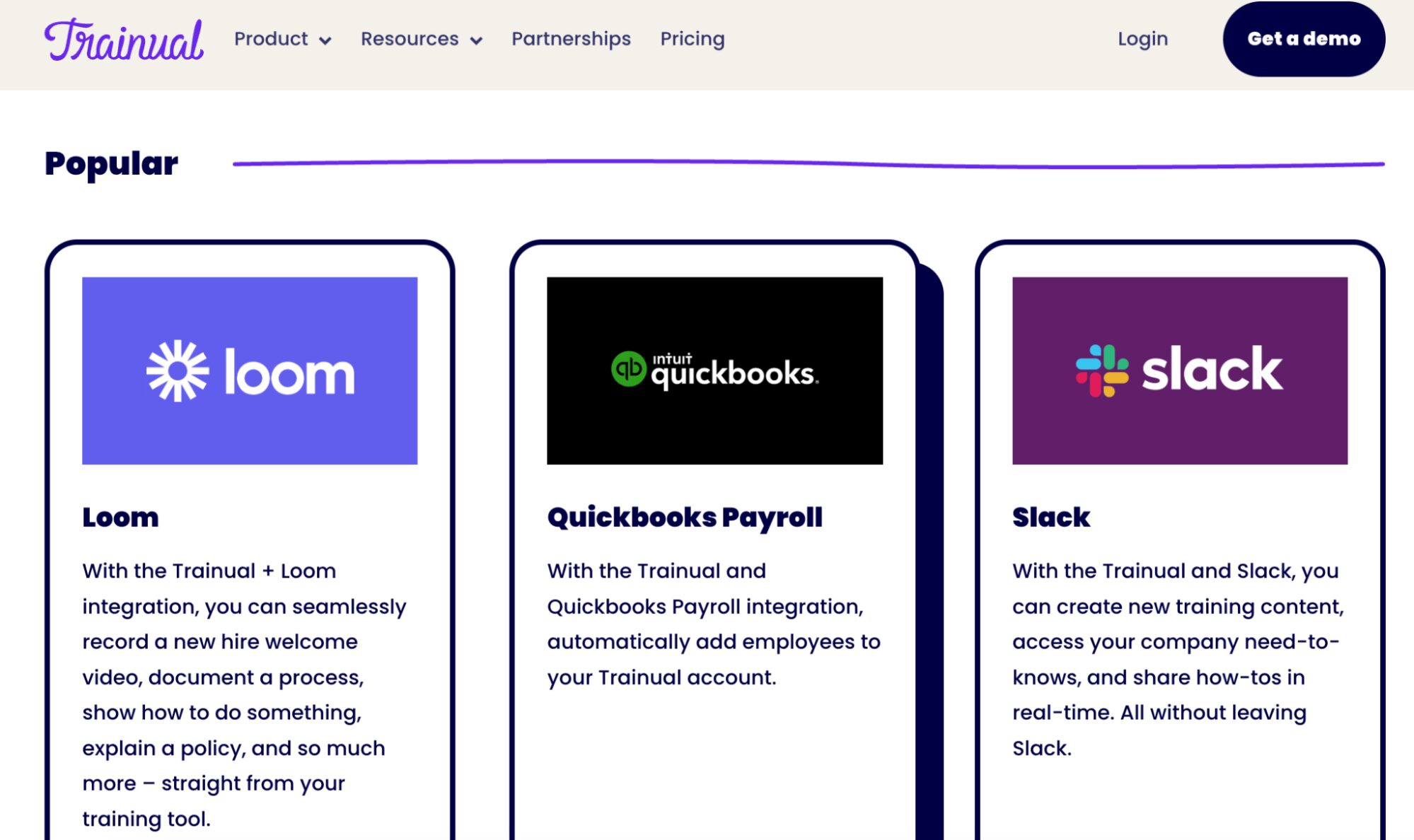
On the other hand, Whale focuses on integrations that enable in-workflow documentation access, such as Chrome extensions, Slack, Microsoft Teams, and Google Drive. These are ideal for making SOPs accessible without leaving the workspace.
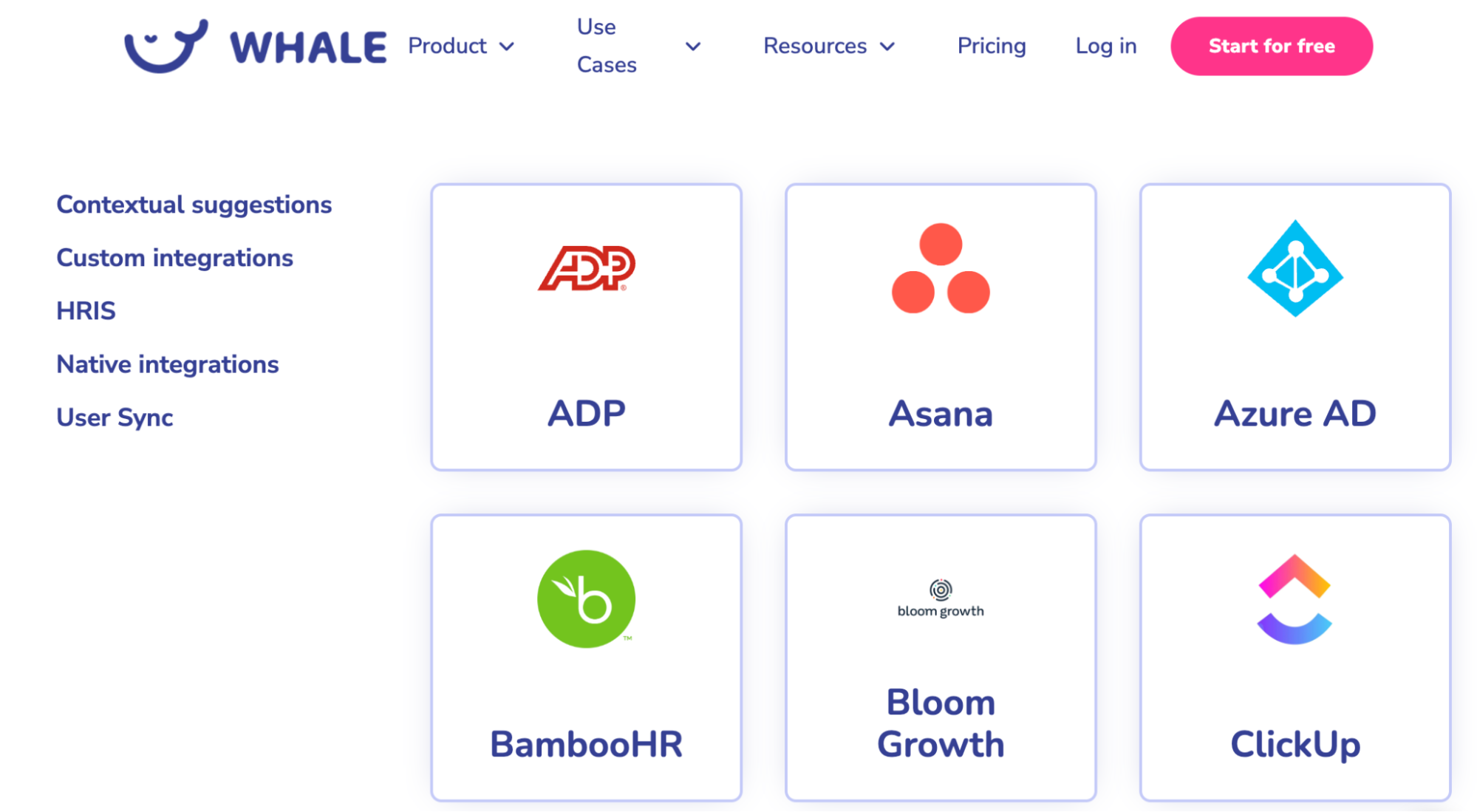
Learning Formats
When selecting a training tool, consider that not all employees learn in the same way. Additionally, not all platforms support a wide range of content types. In this case, Trainual offers multimedia content creation; therefore, you can upload videos, embed documents, create quizzes, insert images, and structure content using rich text editors. It also supports interactive learning, which helps keep users engaged and improves retention.
Whale focuses more on microlearning—short, direct, in-context instructions often tied to specific workflows. While it supports text, images, and videos within playbooks, it lacks assessments or built-in knowledge checks.
Scalability

How well do these tools grow with your company? Trainual is built for scale. Trainual’s role-based assignments, user grouping, and permissions make it easier to stay organized and compliant as your organization adds more roles, departments, or locations.
On the other hand, Whale scales well for small and medium-sized businesses. However, it may be limiting for companies that require advanced analytics or have multiple admin roles. Therefore, it may be ideal as you start your business before your operations become more complex.
Pricing
Before picking an onboarding tool, you need to consider the price. On one hand, Trainual has four pricing plans. You can sign up for the Small plan for $249 per month, the Medium option for $279, the Growth plan for $419, or request a custom quote. All these costs are billed annually.
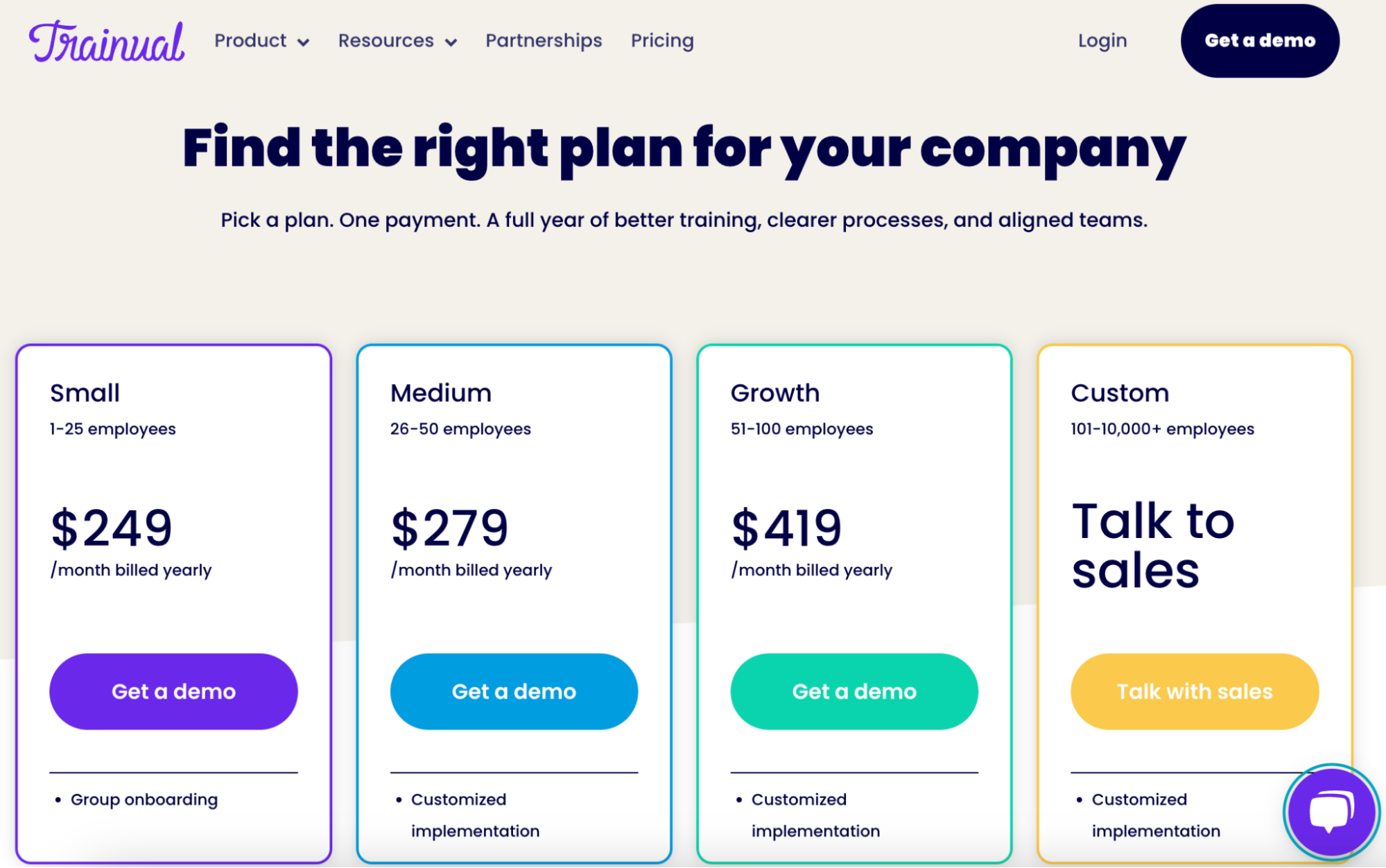
If you opt for Whale, there’s a free plan for small teams of up to 5 users. You can also choose the Scale plan for a growing team that goes for $149/month for 10 users. The Enterprise option is also available for larger organizations.
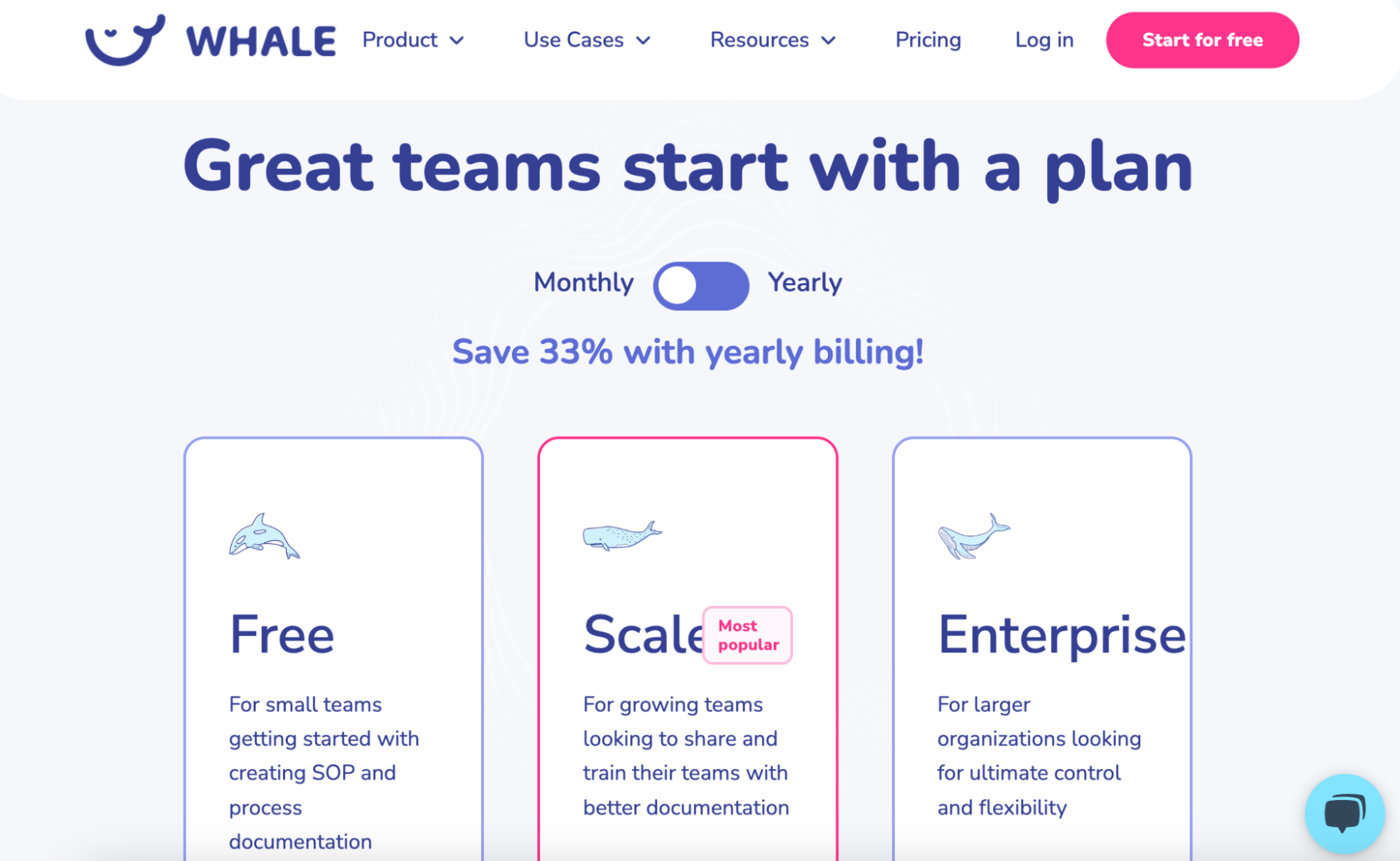
Here’s a simple comparison table summarizing these differences:
| Feature | Whale | Trainual |
| Target Audience | Best for SMBs with fast-changing processes and lean teams | Ideal for startups and scaling businesses needing structured onboarding |
| E-Signature | Not available | Built-in e-signature for training acknowledgments |
| Visual Task Delegation | Checklist-style assignments with limited visual tracking | Task assignment with progress bars and role-based visuals |
| Customer Support | Live chat on the website | Live chat, help docs, onboarding support, and email |
| Flowcharts and Role Chart | Flowcharts are limited to playbook overviews | Organization chart and role-based permissions |
| Integrations | Integrates with Slack, Teams, Chrome extension, and Google Drive | Integrates with Zapier, Slack, QuickBooks, and more |
| Learning Formats | Playbooks, SOPs, bite-sized guides | Videos, quizzes, PDFs, text, rich media |
| Scalability | Works well for smaller teams; limited depth for large orgs | Better suited for growing companies with multiple departments |
| Pricing | Starts at $249/month, billed yearly | There’s a free plan; the premium plan starts at $149/month. |
Whale vs Trainual: Key Similarities
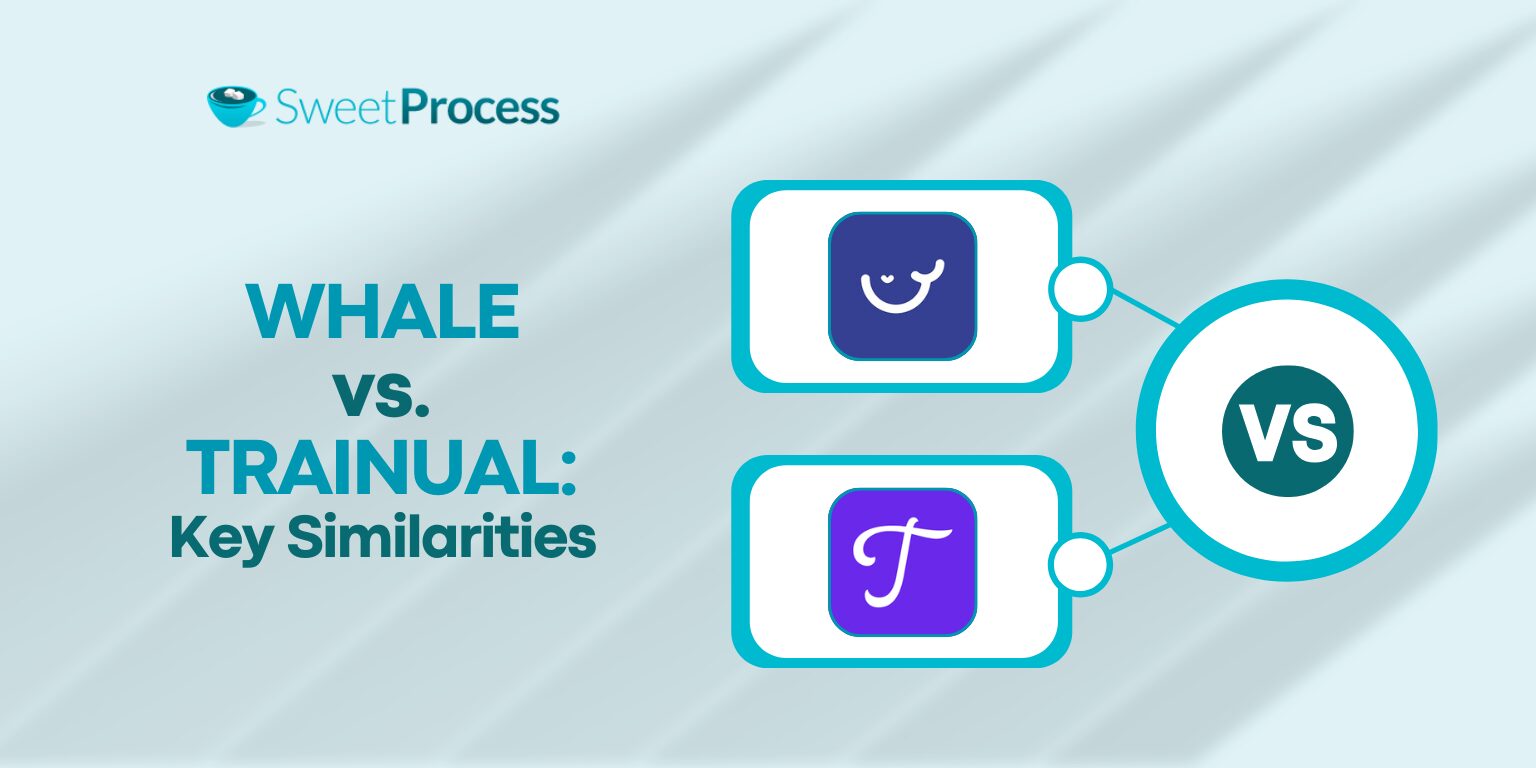
While Whale and Trainual differ in structure and target audiences, they share several core features designed to make training, documentation, and onboarding seamless. Here’s a closer look at how these shared features benefit your team:
Unlimited Documentation
Both tools cover the needs for creating an extensive knowledge base. Whale and Trainual offer unlimited documentation, allowing you to create as many SOPs, policies, training modules, or process guides as your team needs. This is especially helpful for businesses with growing knowledge bases or frequent process changes.
For example, suppose your HR department wants to document everything from PTO policies to harassment training, and your operations team needs step-by-step guides for daily tasks. In that case, both platforms provide an avenue to create all the documentation from one place.
Group Content Assignment
As you train and onboard new team members, you need a tool that allows you to assign content to everyone. Fortunately, Trainual has features that allow you to define responsibilities and link them to relevant policies and SOPs for better role execution. Whale also lets you group users by department, role, or location and assign relevant training or documents to those groups.
This ensures everyone receives the most relevant material without manual one-by-one assignments.
Training Paths
Both Whale and Trainual support training paths. Your team can use these structured content guides to learn more about the company. For instance, you can group multiple SOPs, policies, or onboarding materials into a logical order that reflects the expected progression of an employee.
As the employees learn, it’s also easy to monitor completion steps and assess progress from the platforms. This way, you can roll out the onboarding process gradually to ensure that the new hires fully understand the information.
Multi-Language Training
If your operations are split between different countries, you need a tool that handles language translations. Multi-language training features allow organizations to deliver onboarding and SOP content in various languages.
Trainual offers the ability to duplicate content and translate it manually or via integration tools, while Whale has built-in multi-language support across its interface and documentation tools. Admins can manage user language preferences, ensuring employees view materials in the language they’re most comfortable with.
AI Capabilities
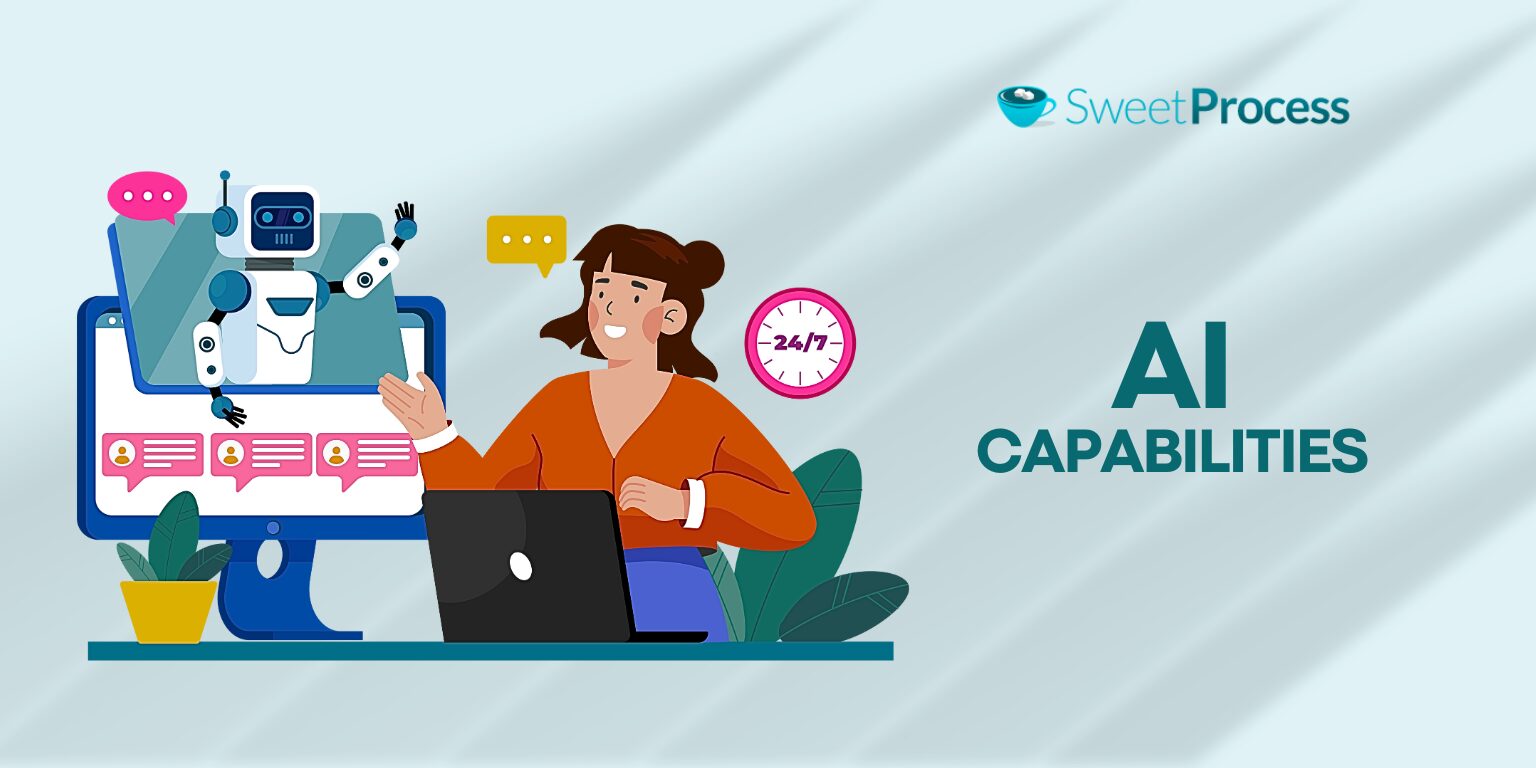
AI helps you create content much faster. Both Whale and Trainual have started integrating AI-powered tools that assist with content creation, editing, and optimization. These tools help reduce the time it takes to draft SOPs or training guides by providing AI-generated content suggestions.
You can use AI to summarize documents, rewrite sections, and generate playbooks. This way, your teams don’t need to create documentation from scratch.
Autogenerate Tests
Each platform offers auto-generated quizzes based on the content in a training module. This means admins can input their SOPs or learning materials and let the system automatically create assessment questions. For instance, you could create multiple-choice questions tied to specific training sections to test users’ retention.
This feature helps measure understanding and reinforce learning without requiring admins to manually build tests, which could take a lot of time.
Content Translation
In addition to supporting multiple languages, both Whale and Trainual offer content translation capabilities. This feature allows you to translate specific SOPs or modules for different user bases.
While Whale offers automatic and manual translation options within the document editor, Trainual provides a content duplication workflow, where content can be copied and translated into another language, preserving the structure and formatting.
Single Sign-On (SSO)
As digital platforms become the norm, it’s vital to pick a tool that offers proper security features. The Single Sign-On (SSO) feature enables employees to access the training system using their existing credentials, such as those for Google Workspace or Microsoft Azure.
This integration streamlines the login process, improves security, and reduces administrative overhead, especially for large teams. It also ensures tighter access control, as user sessions and permissions can be managed.
Customization and Content Embeds
With both tools, you can customize platform colors and logos to align the tool with your company’s brand. Additionally, you can embed rich content, including videos, PDFs, Google Docs, spreadsheets, and more, directly into training modules. This creates an interactive learning experience, allowing teams to consolidate all relevant resources in one place.
When content is visually appealing, it becomes easier to consume, which is ideal for onboarding new hires.
Process Capturing
You don’t want your new hires to miss out on any key details during training. Process capturing allows you to demonstrate the work more clearly. Both Whale and Trainual offer tools and browser extensions that enable you to record on-screen activity and convert it into step-by-step guides.
This functionality reduces friction in SOP creation, as team members no longer need to describe steps manually.
Groups and Permissions
Permission management is a shared strength in both platforms. Admins can control who sees what content, who can edit or publish materials, and who receives training assignments. Trainual offers granular access control at the document and topic level, while Whale provides team-level permissions to limit content access based on roles or functions.
This ensures that sensitive documents are protected and users only see content relevant to their roles, minimizing confusion.
Cons of Whale

Although Whale offers several features to help you onboard new hires, users seek a better alternative. Here are some of the reasons why:
Heavy Reliance on Zapier for Extended Integrations
Many Whale users lean on Zapier to connect Whale with other apps, which means you incur extra complexity and potentially additional Zapier costs, just to get basic workflows automated. Without native integrations, teams must rely on Zapier to fill the gaps.
However, if you opt for a tool like SweetProcess, you can access multiple integrations directly via a simple API, with no need for third-party connectors. You can integrate with the SweetProcess API to automate user onboarding, task assignments, and notifications seamlessly, eliminating the need for Zapier in most common workflows.
Limited Formatting
Users report that the platform offers limited formatting options, especially if you want to customize your documents. This makes it challenging to maintain a consistent visual structure when importing documents.
On the other hand, SweetProcess is built to preserve your formatting, even if you’re importing external documents from Word, Google Docs, or PDFs. Your existing process docs are ready to use, reducing the migration time.
To import a document, click the “Procedures” tab, tap the drop-down button, and select “Upload document.”

When a pop-up window appears, browse your computer to pick the document you want to import.
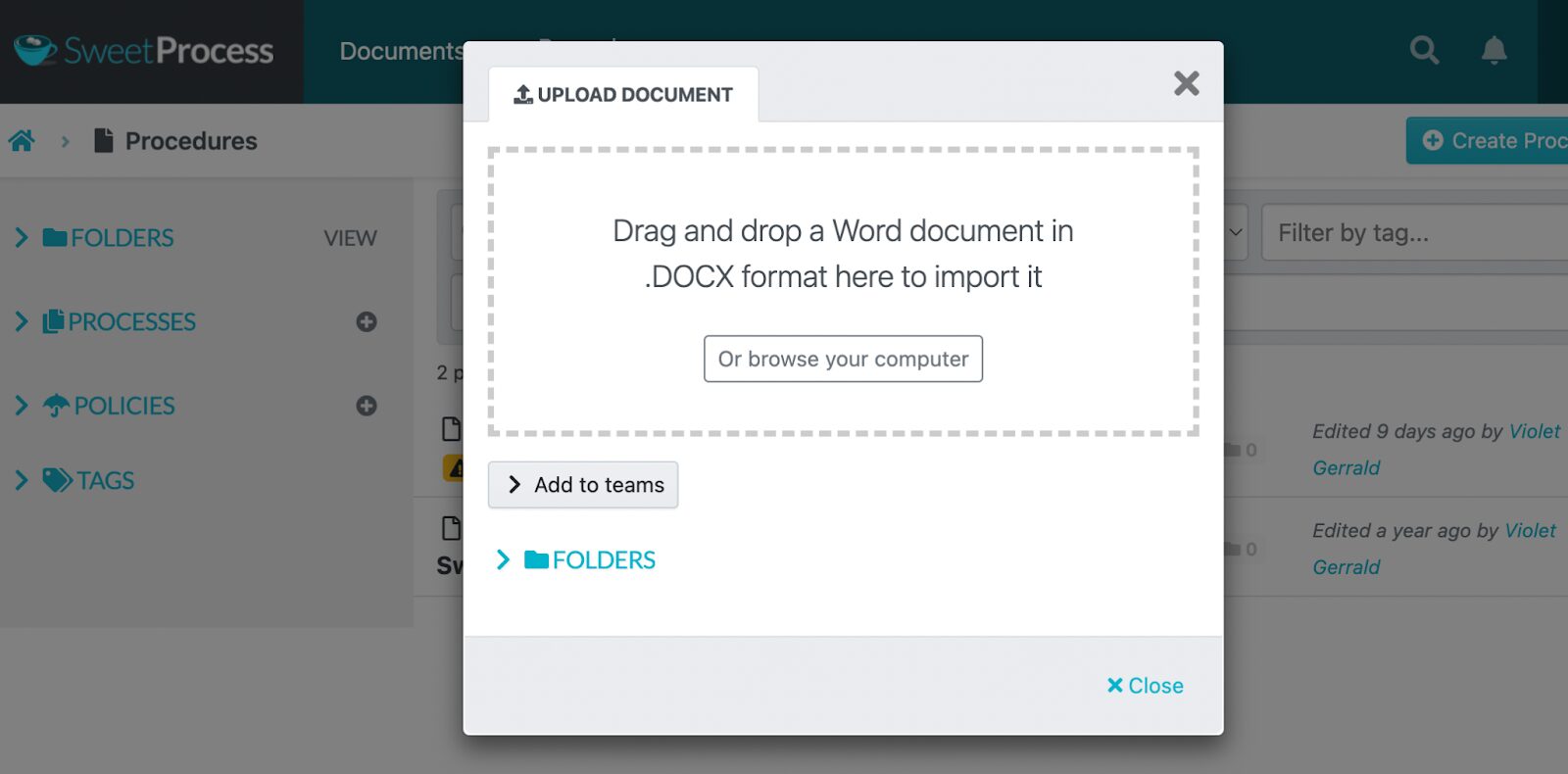
This process takes a few minutes. Your team can then access the procedure from the dashboard.
Role‑Based Pricing May Become Expensive for Large Teams
Whale’s pricing model is limiting. While you can use the Free plan if you have 5 team members, the premium option goes for $149/month if you have more users. You can also opt for the Enterprise plan, for which you must contact the team for a quote. In addition, you have to pay more to access advanced features.
On the other hand, SweetProcess offers a simple, transparent pricing that includes unlimited contributors and viewers. Once you pay the subscription fee, you can access all features at no extra cost. If you add more team members, you’ll be charged $5/month for every active member. This makes scaling more straightforward.
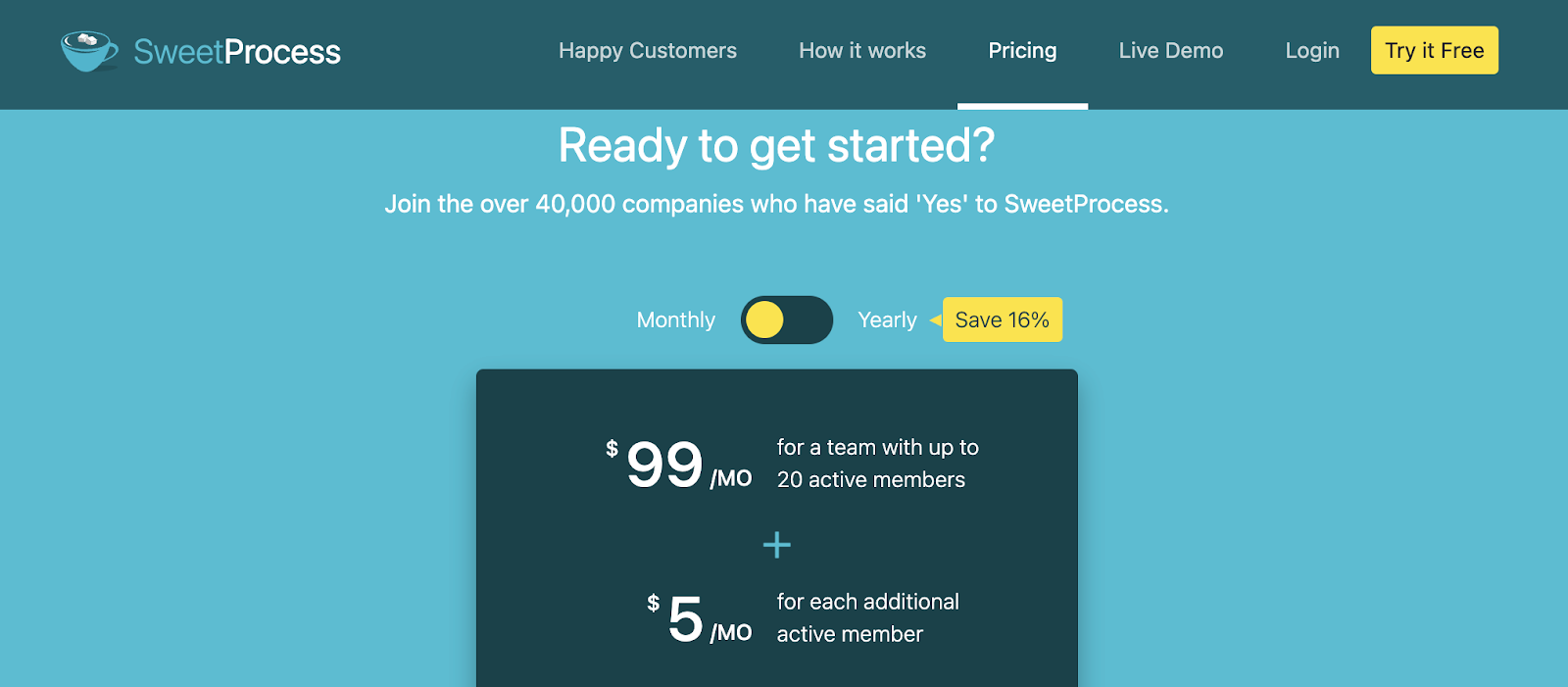
Cons of Trainual
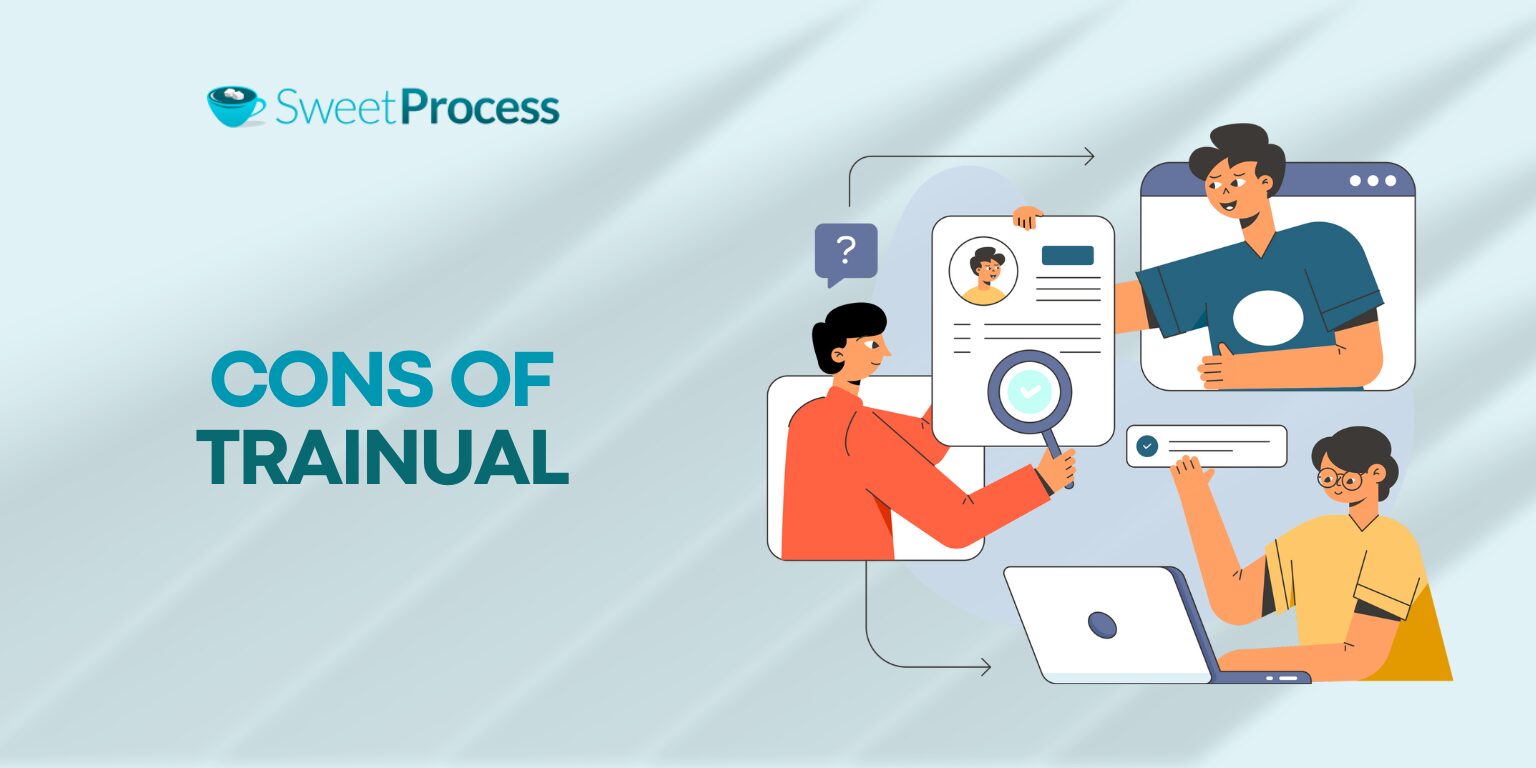
Trainual comes with some downsides that may not be ideal for your business. Here are the cons of this platform:
Steep Learning Curve
Some users have noted that setting up Trainual can be confusing, which makes it challenging to onboard new hires. In this case, your team will spend a lot of time trying to understand the platform instead of following through with the training.
This is not an issue with SweetProcess, since there’s no learning curve. As soon as you sign up for a new account, you can start using it for free for the first 14 days.
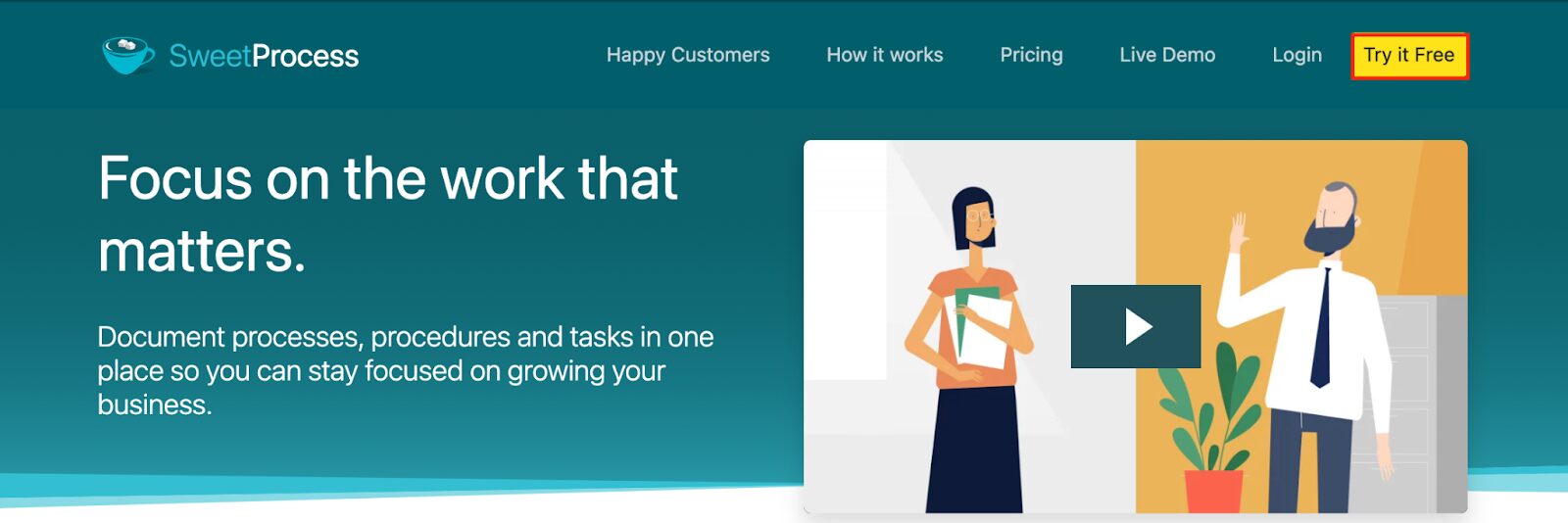
All the policies, procedures, and processes can be viewed from the dashboard, making it easy to navigate and switch between tabs.

New hires won’t need technical skills to use this platform for training.
Limited Customization Options
Trainual’s layout and branding options are not too flexible. Therefore, if you want to customize your training portal, you may not be able to access all the options you need to make it comprehensive. However, with SweetProcess, you get multiple customization options, including custom color schemes, your own domain, an option to embed your logo, and flexible page layouts.
These features allow you to personalize your training materials.
Essential Features Not Available to All Users
Some key features, like quizzes, unlimited e‑signatures, or advanced reporting, are locked behind higher‑tier plans in Trainual. Therefore, smaller teams can’t access them without upgrading.
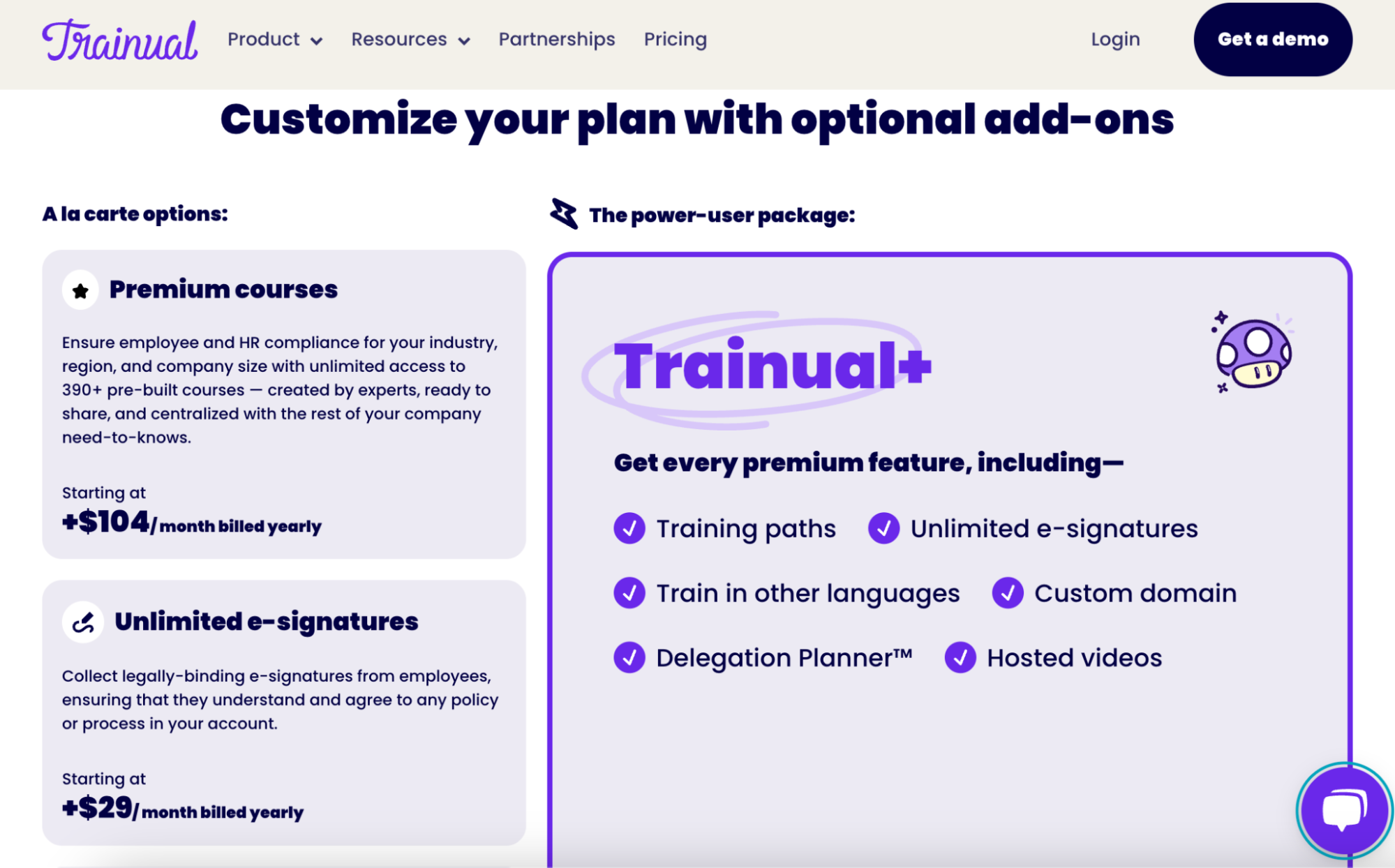
With SweetProcess, you can access all features as soon as you pay the subscription fee. There are no extra costs to access any functionalities.
Limited Native Integrations
While Trainual integrates with common tools via Zapier, there are gaps. The native integrations are insufficient, which affects connectivity, particularly for industry-specific apps.
However, if you opt for SweetProcess, the tool integrates with over 1,000 apps via the API or Zapier. Therefore, you can easily sync the software with your existing tools to make onboarding more seamless.
SweetProcess: The Whale and Trainual Alternative For Training Employees
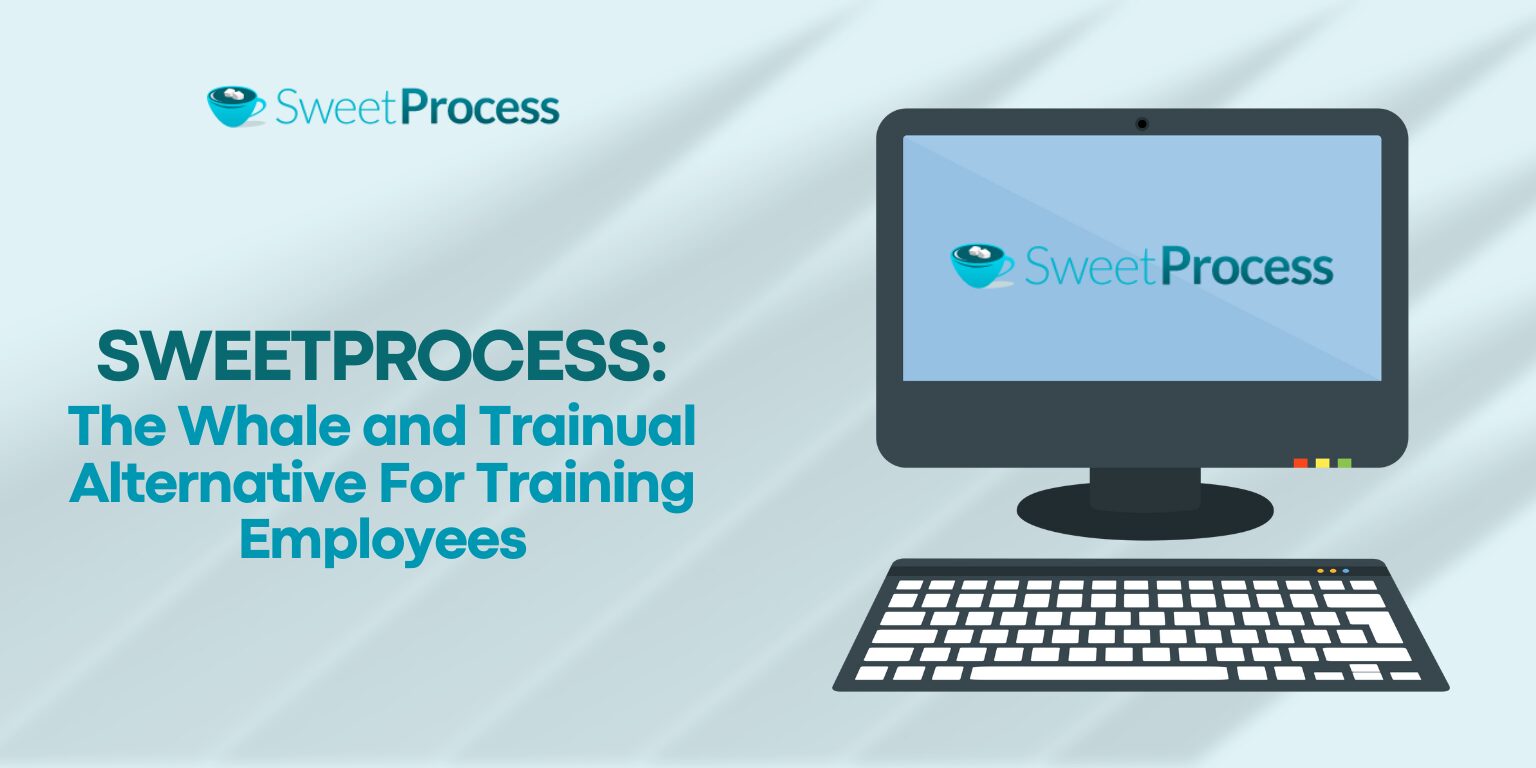
When it comes to onboarding and training, you need an intuitive and simple tool. Now that we’ve identified that Whale and Trainual have some limitations, you need an alternative solution. SweetProcess stands out for its robust features and design, which are created for all types of organizations and teams.
You can easily write your standard operating procedures and document your training materials on a single platform. Task management is also quite straightforward, since you can assign responsibilities without leaving the platform. You access all these features without the hidden pricing and steep learning curve found on other platforms.
Here’s how SweetProcess gives you everything you need to onboard employees and train them:
Create Training Documents for Employees
With SweetProcess, you can create structured, step-by-step procedures and training guides that are easy to follow, whether documenting how to handle a customer escalation, using a tool, or running payroll.

Each document includes clear headings, checklists, embedded images, videos, or even screen recordings to walk employees through exactly what to do.
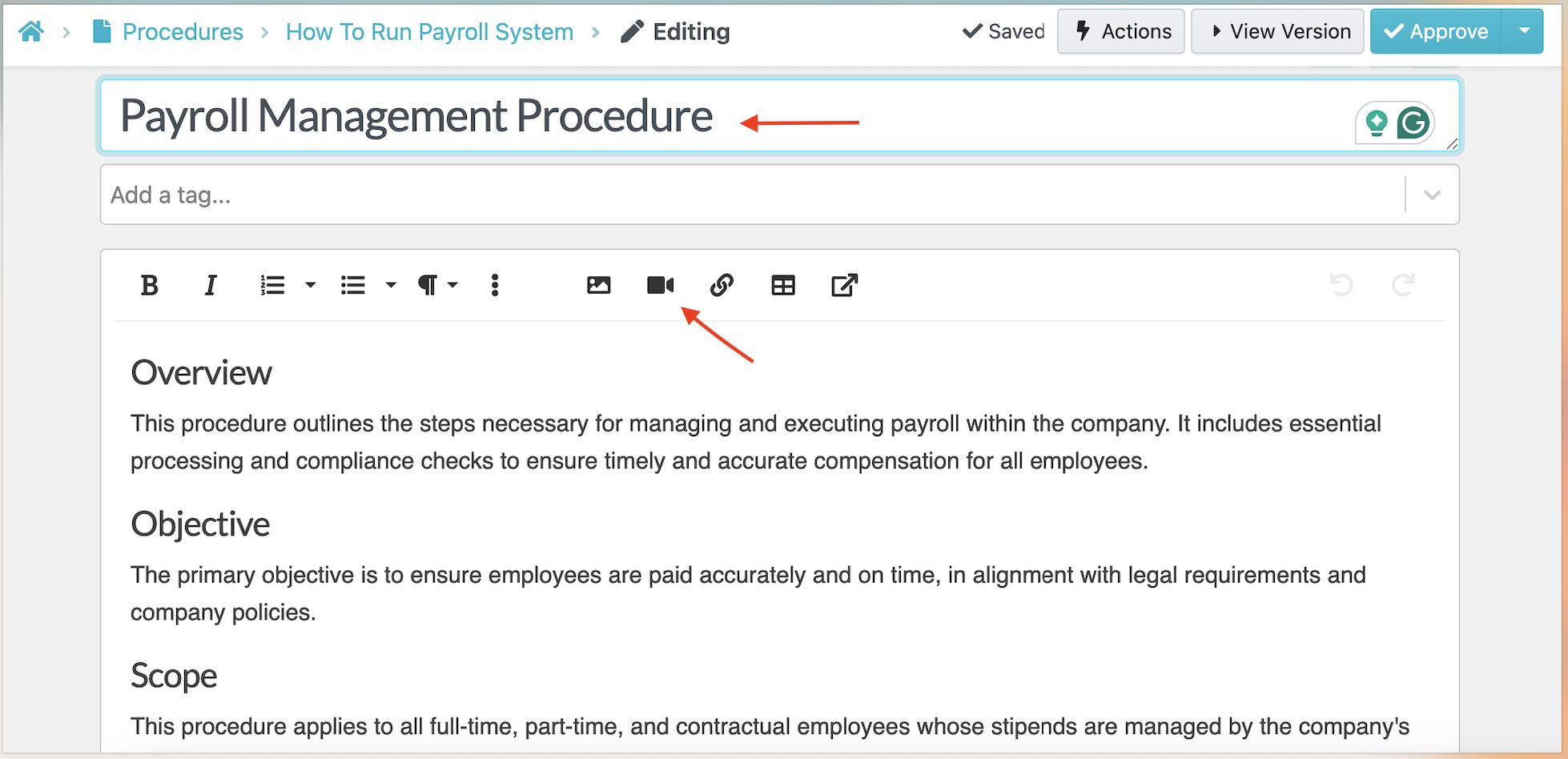
Build an Internal Knowledge Base for New and Existing Employees
SweetProcess makes it easy to turn your organization’s documentation into a centralized, searchable knowledge base. You can organize procedures by department or topic, ensuring every team member can quickly find what they need and when needed.
To create an internal knowledge base on SweetProcess
- Click the “More” button and select “Knowledge Bases.”
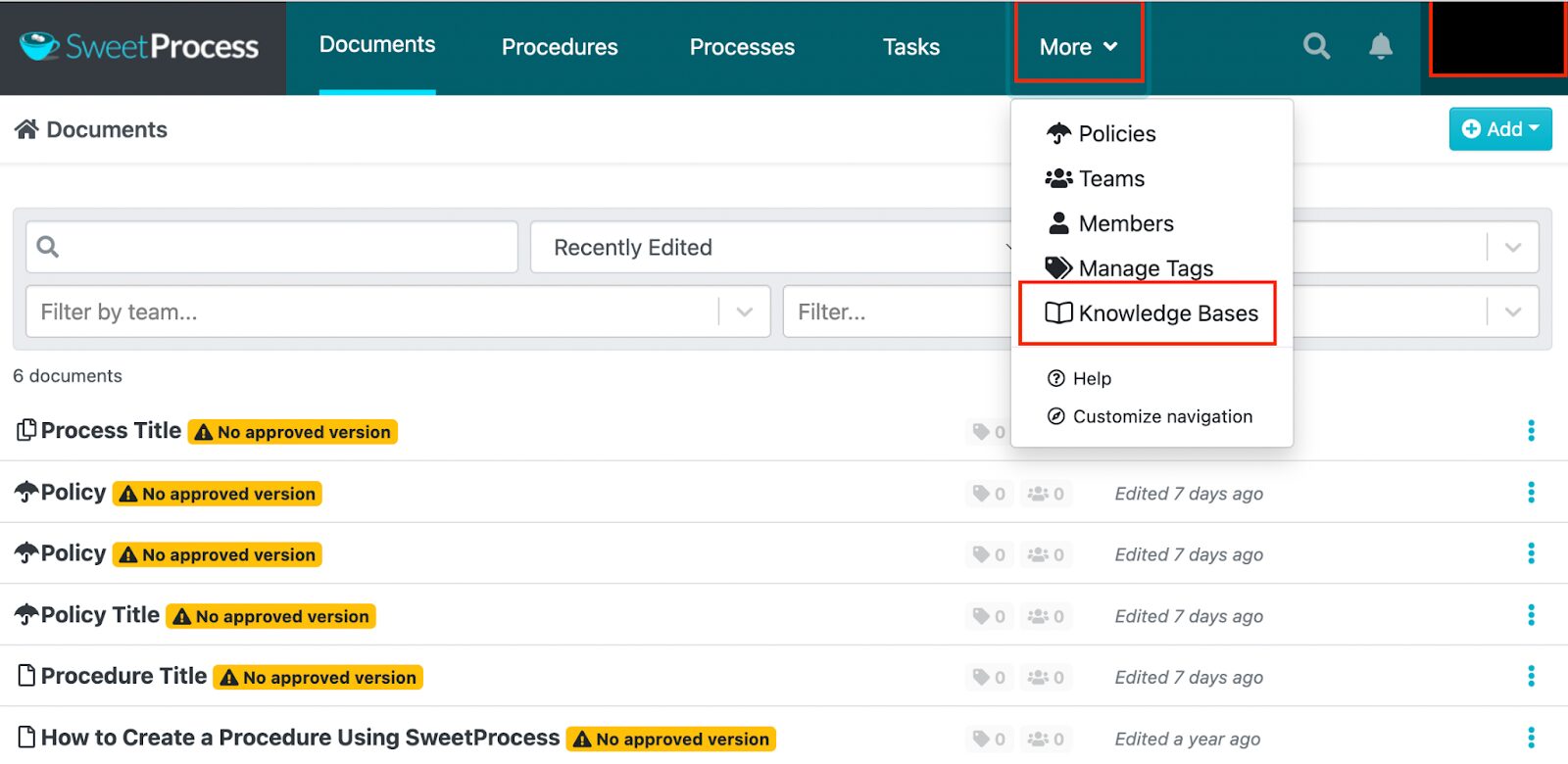
- Select the “Create Knowledge base.”

- Add a title.

Since it’s for internal use, scroll down and select the private knowledge base option.

This internal knowledge base is accessible 24/7 and fully customizable to reflect your company’s structure. And because permissions are role-based, you can ensure that sensitive content is only visible to those who need it.
Assign Procedures As Tasks to Employees
Need to make sure a new hire follows specific steps? With SweetProcess, you can assign any procedure as a task. Employees will receive these instructions, deadlines, and checklists on the platform, and managers can also track progress in real time.
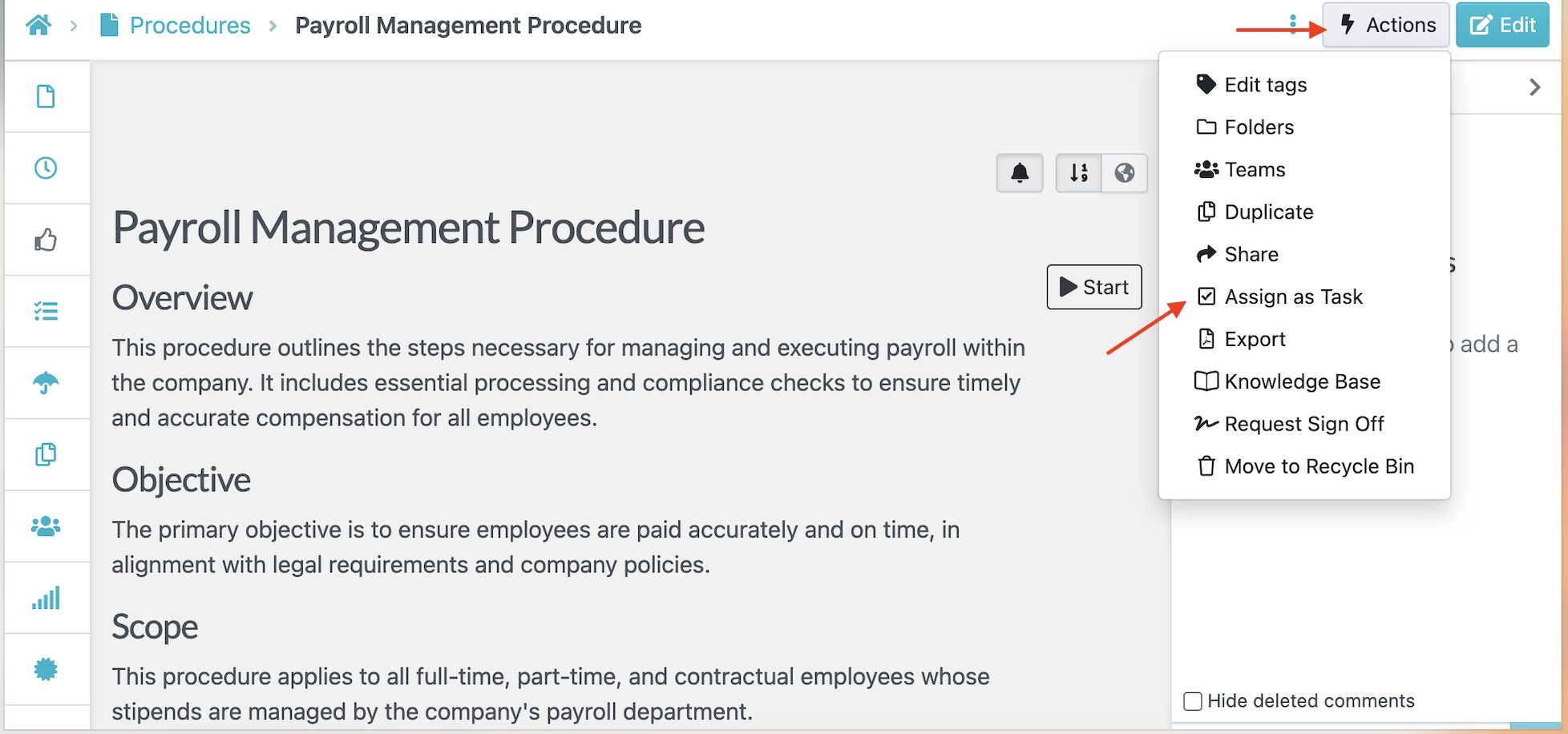
This built-in task assignment system means you no longer have to send process documents over email or Slack. Everything happens within SweetProcess, keeping training accountable and centralized. You can pick the specific team members for easier task management.
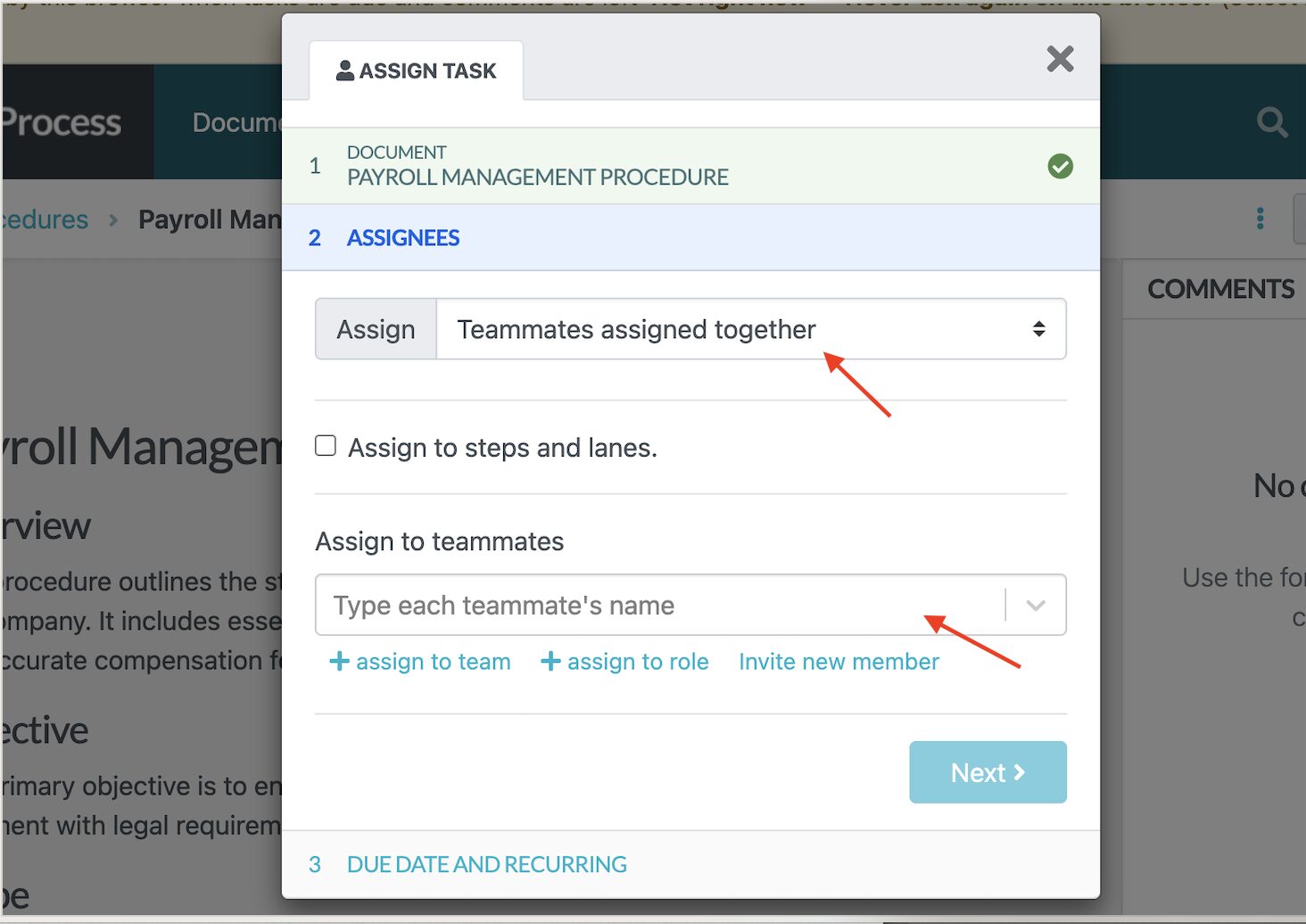
Assess Employee Knowledge With Quizzes

One of the most effective ways to ensure employees understand what they’ve learned is by administering quizzes. SweetProcess allows you to create quizzes tied to your SOPs or training content.

- As you add details to the quiz, you can add time and a pass mark.
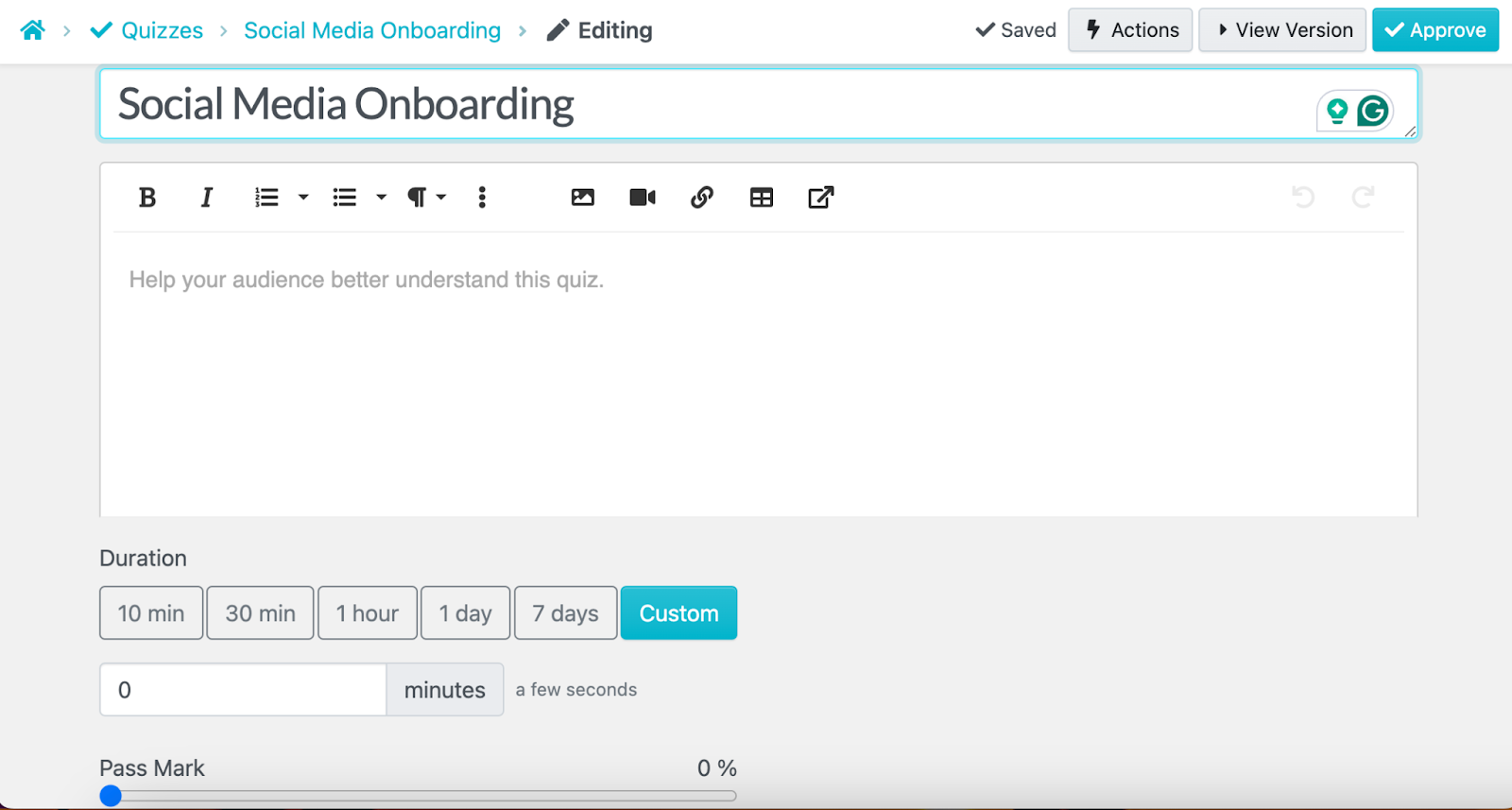
- In addition, you can recommend documents that new hires can read before taking the quiz.

These quizzes are perfect for onboarding, safety protocols, compliance training, or even periodic refreshers.
Collaborate Seamlessly With New Employees
SweetProcess was built for collaboration. Your new hires can leave comments, ask questions, or suggest improvements directly on the training documents.

You can also invite team members to co-edit, track changes in real time, and keep everyone aligned on process updates, without switching between tools.

These features have come in handy for several businesses. One of them is Everywhere Wireless, a fast-growing internet service provider. The company struggled with maintaining consistent employee training as the team expanded. Their knowledge transfer relied heavily on verbal communication and one-on-one coaching, which became unsustainable as new hires joined across departments.
In search of a scalable onboarding solution, Tom Vranas, the vice president of innovation and culture, adopted SweetProcess to bring structure and clarity to their training programs.
This move changed their onboarding process. Tom says,
“For us, it had to be a tool that anyone could access. The idea is that anyone should be able to create, edit, and suggest because that’s where the knowledge comes in…Within a minute, anyone who logs into the system can do exactly what they’re needing to do. It really had like the exact feature set.”
Thanks to SweetProcess, the company now has:
- Standardized training across departments with structured SOPs
- Built a centralized knowledge base for long-term knowledge retention
- Improved employee confidence and autonomy during onboarding
- Reduced customer support response times through better internal alignment
Another company is Thimbleberry Financial, a financial advisory firm led by Amy Walls. They faced a common and frustrating challenge—training new employees using outdated, scattered Word documents. Without a centralized system, onboarding was inconsistent and time-consuming, often requiring one-on-one guidance to walk new hires through basic procedures.
Amy and her team began searching for a streamlined and more effective approach, and in the process, discovered SweetProcess. Immediately, they saw the potential in having all their processes documented and easily accessible in one place. Here are some of the benefits they have received from this switch:
- They centralized all company procedures into a single, searchable system
- The new hires could self-onboard with minimal supervision
- There’s reduced training repetition for managers and improved team productivity
- Increased consistency in how tasks and responsibilities were executed
Whale vs Trainual: Which Is Better for Employee Training and Onboarding?

Your choice of software should positively boost the onboarding process. Although Whale and Trainual have valuable features for documenting processes and training employees, they serve different needs. Whale can be limiting for teams looking to scale, and Trainual’s steep learning curve can slow down an organization, driving up onboarding costs.
If you’re looking for a simpler, more scalable Whale alternative that can also stand in for Trainual, blending the best of both platforms, SweetProcess is the answer. It offers everything you need to create SOPs, assign tasks, onboard new hires, track progress, and even quiz team members. It is your go-to knowledge-sharing solution.

